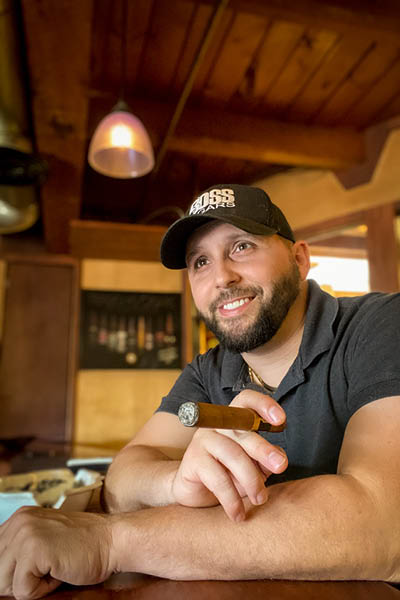When a manufacturer sends products for his store to sample, Frakes disperses those samples to several different groups within the store. One group is his family, who owns and runs Industrial Cigar Company. Each family member smokes the cigar and tries to decide how that product can fit into the humidor and what it has to add. Beyond product characteristics, they want to know more about the manufacturer. What’s their story? What’s their personality? What’s their reputation within the industry? How do they treat other retail partners?
Once a product makes it past this stage, it then enters into a launch program. This involves an event where the brand owner engages with the customer base, either through an in-store event or virtually. These events are developed around the idea of educating the store’s customer base about the manufacturer, their company and their product. This rigorous, multi-pronged plan has helped successfully launch several brands within Industrial Cigar Company, including those that may be newer to the market. Smoking the product is a very important factor in choosing what to carry or what to pass on, says Talanca.

“You have to smoke the product,” he says. “There’s associations you can make with different tobaccos if you sell a lot of this brand, and this guy’s got this over here and it’s something new—there might be some similar or common ground as far as flavor profile that could be something you might want to try.”
Smoking the product is an important part of the sales process, as is forming a close relationship with manufacturers and their sales representatives. What happens, though, when a particular product doesn’t sell like you thought it would? Talanca urges retailers to manage their expectations and state up front that while your store may be willing to give a new brand and its products a shot, it may not work out. Revisiting the products in six months can give both the retailer and manufacturer time to reevaluate how to better position a product in a store. Retailers should also take some initiative and use different merchandising techniques to bring attention to slow-moving products.
“When we bring in good cigars and maybe they don’t sell, we just make some assorted packs with them. People like to try those. It at least gets that cigar in their hands,” says Kelly.
In addition, don’t forget the importance of first impressions, an idea that even applies to the initial impression your store’s humidor gives your customers. Humidors should be tidy and well lit. All three tobacconists on the panel urged retailers to line their humidors with LED lighting and to develop a lighting structure that helps customers move through the humidor and explore its contents.
“There’s a reason why all airplanes have escape lighting down the center,” says Frakes. “We can guide [our store’s customers] with some lighting. It’s amazing the number of humidors that are just dank, dark areas. Bring some freshness and vibrance to it.”
“Being an electrician for 20 years, I can say that lighting is so key,” adds Talanca. “I mean, when you go purchase a car or something, you’re not shopping at night, right? You want to see it out there; you want to be able to see what color it is. And LED strips are so cheap these days. There’s no reason not to have your shelves lit.”
Also, don’t be afraid to change things around to help bring attention to all of the products you carry. Kelly and her staff at Queensbury Cigar & Pipe move things around several times a year and says that customers will take notice of items they had previously overlooked. After these mini makeovers, they’ll notice an uptick in sales associated with products that hadn’t sold before. Changing things up and presenting your store and its products differently to customers is an easy way to get your customers interested in what your store has to offer them.
This Year’s Biggest Challenges
Taxes and local regulations are two pressing issues that concern these tobacconists today. In New York, Kelly’s retail business has to grapple with a 75 percent tax rate that makes it hard for her brick-and-mortar to compete with online businesses. She often sees customers who will come in and buy several individual cigars and will hear that the same customer will go online to buy a box because the price is often better due to lower taxes. This is a problem that Kelly tries to solve and work on alongside other tobacco retailers in the state.
“It’s good to work with other shops as a united front,” she says. “We’re working on a 50 cent tax cap—that’s a bill that’s in the Senate and Assembly in New York. Fingers crossed, it’ll pass in April. That would be a game changer.”
In Texas, Frakes’ biggest challenge involves successfully carrying out new initiatives while continuing to meet and exceed customer expectations. “Our challenge is spinn[ing] new plates while retaining the level of experience that we expect here. Are there reasons for people to come back? Are the ashtrays constantly clean? Are we able to onboard a sufficient number of teams? By the time we get to this point—to open the next location—are we successful in growing and retaining what our brand is? That is our biggest challenge: creating an experience that is replicable but doesn’t feel corporate, doesn’t feel like a franchise; it feels like who we are.”
Talanca’s biggest concern in 2022 is one shared by many retailers: the ongoing disruptions impacting the supply chain. “There are a lot of companies right now that are trying to catch up,” he states. “This whole corona[virus] thing has affected the industry in another way. When we order, say, 30 boxes, and I get five, what am I going to do with that? Now somebody has to be really proactive in that humidor and go, ‘Alright, do I take this off the shelf? What do I replace it with? How do I maintain this brand that people love and enjoy?’ It’s hard to get product, and I’m curious to see what’s going to happen this year.”
You can watch this panel and others that were part of this year’s TPE Ignite Online Educational Series at tobaccobusiness.com/category/tpe-show.
This story first appeared in the March/April 2022 issue of Tobacco Business magazine. Members of the tobacco industry are eligible for a complimentary subscription to our magazine. Click here for details.







